Little Staughton Church

The church from the south January 2017
This article was written by Jeannette Atkinson and Brenda Foster
Establishment and name
Early records show that Little Staughton Church had a rector from 1245 (Henry de Etton, who was appointed by the Master of the Knights Templar) and the church was originally named St Margaret’s after St Margaret of Antioch (the Catholic patron saint of childbirth - Knotting church is also dedicated to this saint). When the Crusaders returned to England more than 250 churches were named after this saint. At some time in the nineteenth century the church was renamed All Saints; the reason for this is unknown. A chapel dedicated to St Margaret was reinstated in the church in 1937 near to her feast day of the 20 July.
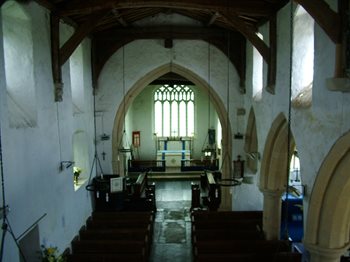
The interior looking east - copyright All Saints Little Staughton
Architecture
O’Brien & Pevsner describe All Saints Church, Little Staughton as making a dramatic picture seen from the North as it sits alone on a ridge away from the village (The Buildings of England, 2014, p210). The Grade 1 listed church was developed from a thirteenth century aisle-less nave and chancel of equal width and built in brown cobbles and limestone. The south aisle and chapel were added in the fourteenth century and the present chancel, clerestory and west tower date from the fifteenth century (BHRC Bedfordshire Churches Part III V79 ed. Pickford).

All Saints Church from the south – copyright All Saints, Little Staughton
Unusually, for medieval churches of this age, All Saints is still in its post-reformation decor. It is plain white inside with mostly clear glass windows; some fragments of medieval stained glass can be seen in some windows. The medieval church would have been full of colour: stained glass windows; coloured wall paintings and; statues, many of which were destroyed at the start of the Reformation (circa. 1530).
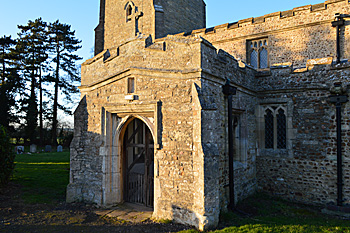
The south porch January 2017
The south porch, built in the fourteenth century, stands witness to the damage done at this period:
- on either side of the porch entrance are two shields the detail of which has been lost;
- stone carvings, probably the heads of saints are defaced;
- the small niche over the door, now empty, would have contained a statue of a saint.
This Norman church has been subjected to the vagaries of the weather: due to its prominent position the church has suffered storm damage including lightning strikes (1830, 1901 and 1906). Originally, the tower had a short spire
![The church with capped-off spire [Z1306]](/CommunityHistories/Little-Staughton/The-church-with-capped-off-spire-Z1306183x298.jpg)
The church with capped-off spire [Z1306]
A lightning strike on the 12 June 1900 caused substantial damage to the small spire and during this lightning strike much of the west end of the church was damaged. The Treble Bell was cracked and had to be recast (1901). Restoration was carried out in 1900/01 by Mallows and Grocock on the west end of the church and the chancel roof: at this time the spire was capped. In 1910 a substantially larger spire was rebuilt by WB Stonebridge who, later, added an organ chamber to the north side of the chancel (1942 to 1945).
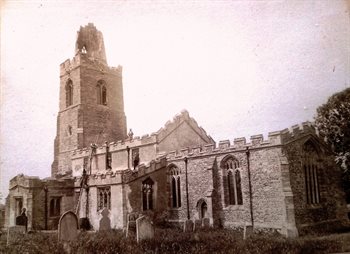
Restoration by Mallows & Grocock 1901 – copyright unknown
Pickford notes that after the 1901 lightning strike ‘the roof was repaired with the old materials, the damaged west gallery was removed, the tower arch was opened up, the enclosed pews were cleared away and the nave was re-seated using the old sixteenth century benches.’ The church was reopened on the 15 October 1901.
The two early pictures of All Saints show that the south side, aisle, clerestory, porch and chancel were all embattled until the restoration of 1900 when the chancel was re-roofed and given a steeper pitch. In 1990, architect Bernard B West comments that ‘In the name of economy one supposes the proper embattled parapet [of the chancel] has been removed and what can only call a lid put on’ (Bedfordshire Magazine, v 22 no172). A zinc roof of a lower pitch was installed in 2014 and the embattlement of the east end of this roof was restored.
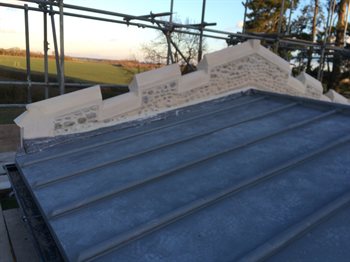
Zinc roof and embattlement restoration – copyright All Saints, Little Staughton
A great hailstorm on Thursday 2nd August 1906 further damaged All Saints. Reported in the Bedfordshire Times (2nd August 1906) it was noted that the Rector of Little Staughton (Rev. Alfred Hancock) was opening a fund for the relief of the men who had suffered serious loss, which at the time was thought to exceed £50,000. Little Staughton was at the centre of a nine mile long and two mile wide storm and the hailstones were pear-shaped and up to 5 inches in circumference. A storm that lasted less than ten minutes smashed many panes of glass (160 in the church alone). Top End was untouched but West End was devastated with the loss of many crops.
An account of the ‘phenomenal storm’ in the London Crusader of September 1906 noted that ‘roots and vegetables were cut to ribbons and fruit smashed to pulp’ and ‘vast tracts of farmland are in dreadful condition. Much of it, especially around Little Staughton, looked as it it had been swept clean by a hurricane of shrapnel’.
The 15th century west tower has four storeys, which were probably built over many years. The spire is recessed and the tower parapet was finally reconstructed in 1982. The tower water spouts are in the form of gargoyles.
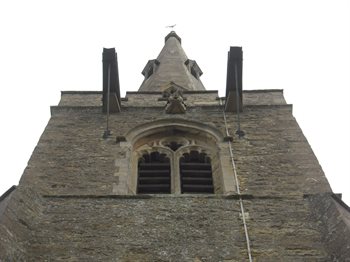
West tower with gargoyle - copyright Brenda Foster
The south door dates from the fifteenth century, it is traceried and shows weathering that indicates this door may predate the South Porch. There is a fourteenth century priest’s door on the south side of the chancel. The oldest door in the church is believed to be on the north side of the nave and may date from the 12th century. The stonework around the west door appears blackened and the reason for this is unclear although remnants of a fire pit have been found in the floor at the base of the west tower. It is thought that the recasting of one of the bells in 1755 may have been done in the church.

The south door - copyright Brenda Foster
Inside All Saints, the nave has a fifteenth century roof which sits on fine carved medieval, undamaged, stone corbels; one represents a cross-legged bagpipe player. There is a three bay arcade (series of arches) on the south side, which is dated around 1300 due to the quatrefoil piers and their capitals.
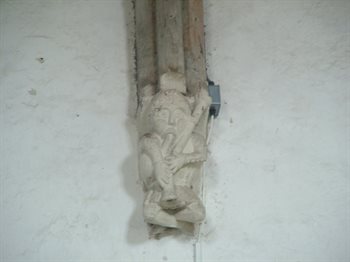
Medieval bagpipe corbel - copyright All Saints Little Staughton
The raised panel, three tier pulpit on the north side of the aisle was an eighteenth century addition, probably given by Corpus Christi College, Oxford. At the same time as a gallery was installed at the West end of the church: this gallery was damaged in the lightning strike of 1901 and was removed in the subsequent restoration.
In the chancel there is the organ chamber with a Conacher pipe organ (installed in 1925), an angle piscine with a shield and a 14th Century recess with crocketed gables and buttress shafts. The recess on the north wall of the chancel is probably a simple Easter Sepulchre; this was a feature of medieval churches that was often destroyed during The Reformation. To preserve this feature from puritanical zeal it was probably disguised as a burial chamber for Reverend William Lake circa 1679.
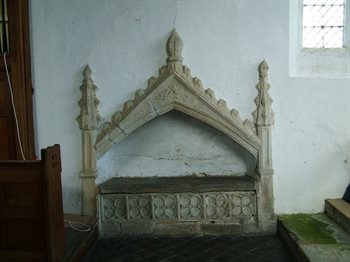
Easter sepulchre - copyright All Saints Little Staughton
A second angle piscina exists in Saint Margaret’s chapel on the south side and there is a hagioscope (squint) to enable worshippers who are not in the nave to see the altar.
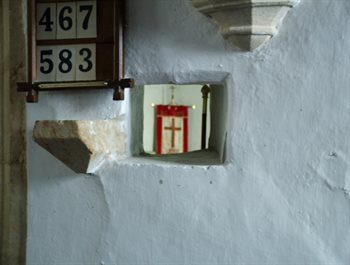
Hagioscope or squint copyright All Saints Little Staughton